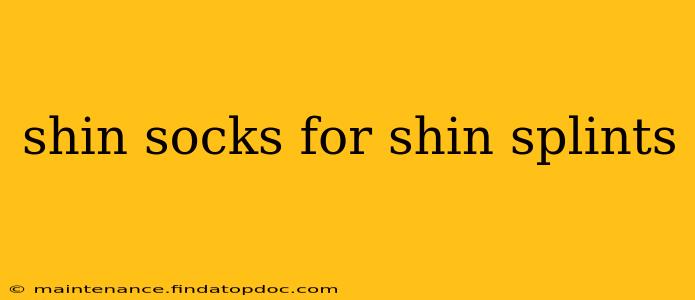Shin splints, that nagging pain along the shinbone, are a common ailment for runners, athletes, and even those simply increasing their activity levels. While rest and proper training techniques are crucial for recovery, the right gear can significantly aid in managing symptoms and preventing further injury. This includes specialized shin socks designed to provide compression, support, and cushioning to the sensitive area. But are shin socks truly effective for shin splints? Let's dive in.
What are Shin Splints?
Before we delve into the benefits of shin socks, let's clarify what shin splints actually are. Medically known as medial tibial stress syndrome (MTSS), shin splints describe pain along the tibia (shinbone) caused by overuse, improper footwear, or inadequate training. This pain arises from inflammation of the muscles, tendons, and bone tissue surrounding the tibia. Symptoms can range from mild soreness to sharp, debilitating pain.
Do Shin Socks Help with Shin Splints?
The answer is a qualified yes. While shin socks aren't a cure-all for shin splints, they can offer several benefits that contribute to pain management and recovery:
-
Compression: Compression socks help improve blood circulation, which can reduce swelling and inflammation. This improved blood flow also aids in the removal of metabolic waste products that accumulate in the muscles after exertion, contributing to pain.
-
Support: Many shin socks offer targeted support to the muscles and tendons along the shin. This can help stabilize the lower leg and reduce stress on the irritated tissues.
-
Cushioning: Some shin socks incorporate padding or strategically placed cushioning to absorb shock and reduce impact on the shinbone, particularly beneficial during high-impact activities like running.
-
Proprioception: The added compression and support can enhance proprioception, which is your body's awareness of its position in space. Improved proprioception can lead to better muscle control and coordination, reducing the risk of re-injury.
What to Look for in Shin Socks for Shin Splints
Not all shin socks are created equal. When choosing shin socks for shin splints, consider these factors:
-
Compression Level: Look for socks with graduated compression, meaning the compression is tighter at the ankle and gradually loosens towards the calf. This promotes better blood circulation.
-
Material: Moisture-wicking fabrics like merino wool or synthetic blends are ideal to keep your feet and legs dry and prevent chafing.
-
Seams: Seamless or flat-seam construction minimizes irritation against sensitive skin.
-
Length: Choose a length that provides adequate coverage, extending above the affected area of your shin. Crew socks or calf-high socks are often suitable.
-
Padding: Look for strategically placed padding that provides targeted cushioning to the shinbone.
How to Wear Shin Socks Effectively
For optimal benefits, follow these guidelines:
- Proper Fit: Ensure the socks fit snugly but not too tight, as overly tight compression can restrict blood flow.
- Cleanliness: Wash your socks regularly to prevent the buildup of bacteria and sweat that can irritate your skin.
- Timing: Wear your shin socks during physical activity and potentially during recovery periods for added support and compression.
Are Shin Guards Necessary in Conjunction with Shin Socks?
H3: Are Shin Guards Necessary in Conjunction with Shin Socks?
Shin guards primarily offer protection against external impacts, such as direct blows from a ball or other players. While shin socks provide compression and support, they don't offer the same level of impact protection as shin guards. Whether you need shin guards depends on your activity. If you're involved in contact sports, shin guards are generally recommended. If you're primarily a runner experiencing shin splints, shin socks may suffice, but combining both could provide additional support and protection.
What other treatments are there for shin splints?
H3: What other treatments are there for shin splints?
Treating shin splints involves a multifaceted approach. Beyond shin socks, other treatments include:
- Rest and Ice: Resting the affected leg and applying ice packs can help reduce pain and inflammation.
- Stretching and Strengthening Exercises: Targeted stretching and strengthening exercises can help improve muscle balance and flexibility, reducing stress on the shinbone.
- Physical Therapy: A physical therapist can provide guidance on specific exercises and treatments tailored to your individual needs.
- Medication: Over-the-counter pain relievers like ibuprofen can help manage pain and inflammation. In some cases, your doctor may prescribe stronger medication.
- Orthotics: Custom orthotics can help correct foot alignment and reduce stress on the lower leg.
Can Shin Socks Prevent Shin Splints?
H3: Can Shin Socks Prevent Shin Splints?
While shin socks cannot guarantee prevention, the support and compression they offer can help mitigate risk factors. By improving circulation, providing support, and reducing impact, they can contribute to a healthier lower leg environment and reduce the likelihood of developing shin splints. However, it's crucial to remember that proper training, appropriate footwear, and addressing biomechanical issues are far more effective preventative measures.
By understanding the benefits of shin socks and integrating them into a comprehensive treatment plan, you can find relief from shin splints and return to your favorite activities with less pain and improved support. Remember to consult with a healthcare professional or physical therapist for proper diagnosis and personalized treatment advice.
